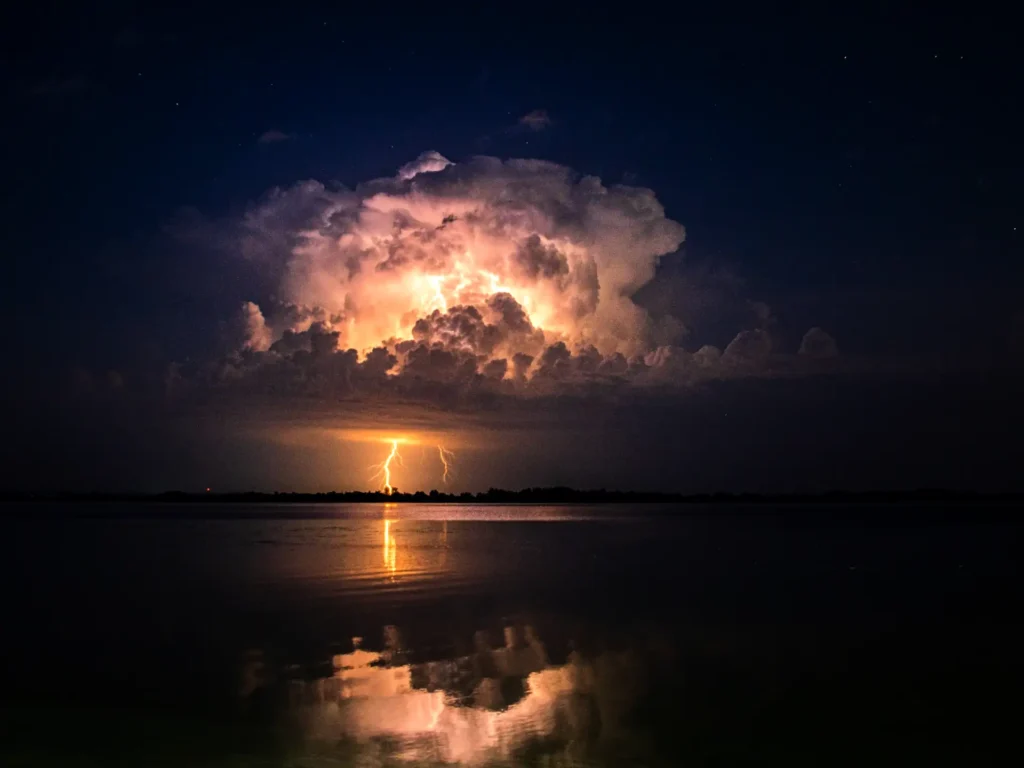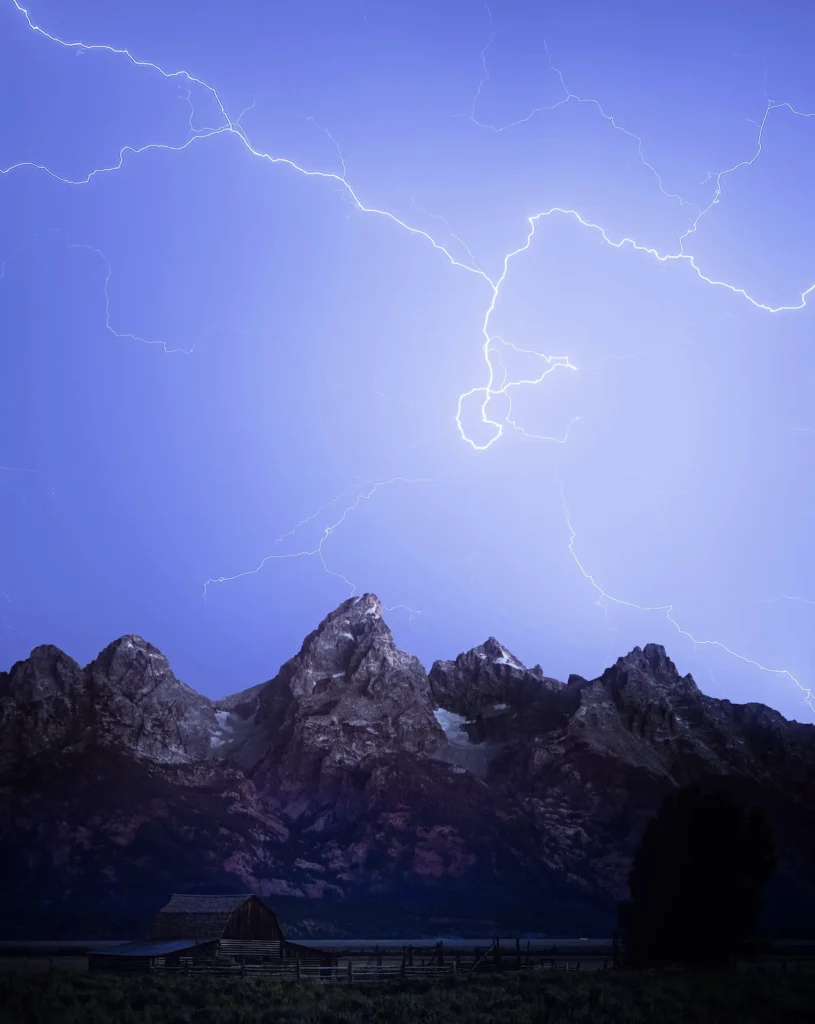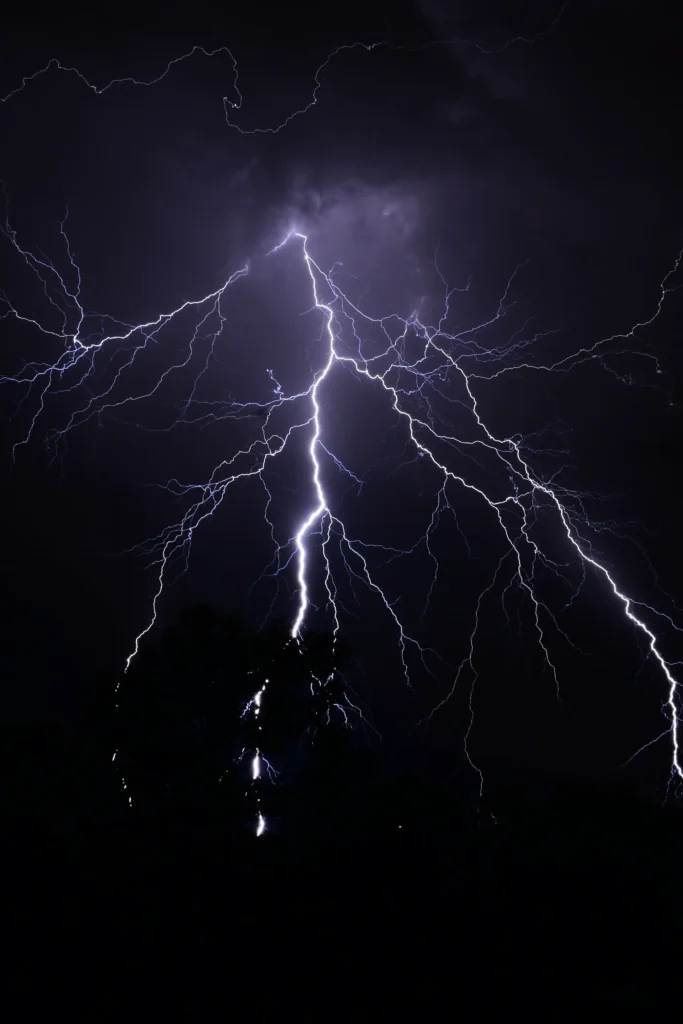13 Lightning safety Tips for hikers
This post may contain affiliate links. This means that we may receive a small commission from purchases through those links. Read more in our affiliate disclosure.
Stay safe on your outdoor adventures with these lightning safety tips. Learn how to protect yourself and enjoy your hiking experience to the fullest.
In a nutshell: Always check the weather before your hike and avoid trails if thunderstorms are predicted. Avoid high points like peaks and ridges; lightning strikes the tallest objects. Follow the 30/30 rule: When the time between seeing lightning and hearing thunder is less than 30 seconds, seek shelter immediately and wait at least 30 minutes after the last thunder before resuming activity. Seek shelter in a substantial building or a vehicle, not under trees. If you’re in a group, spread out to minimize the risk of multiple injuries. If caught outside in open space, crouch down on the balls of your feet, minimizing contact with the ground.

- Introduction
- Lightning and Its Dangers
- What Is Lightning and How Does It Form?
- Types of Lightning Strikes
- Thunder and Its Relation to Lightning
- Safety tips before your hike
- 1. Check the weather forecast
- 2. Regional Weather Patterns and Lightning Risks
- 3. Avoid Afternoon Thunderstorms
- Signs of Lightning Risk
- 4. Environmental Indicators of Impending Storms
- 5. Observe Cloud Formations and Weather Changes
- 6. The 30/30 Rule for Estimating Lightning Danger
- Emergency Measures During a Lightning Storm
- 7. Seek Safe Shelter Immediately
- 8. When Shelter Is Unavailable, move to the safest nearby terrain
- 9. The Lightning Safety Position: A Last Resort
- Group Safety in Lightning Conditions
- Post-Lightning Strike Emergency Response
- 11. Administering First Aid to Lightning Strike Victims
- 12. Ensure Ongoing Safety After a Lightning Incident
- Miscellaneous Advice and Considerations
- Conclusion
Lightning and Its Dangers
What Is Lightning and How Does It Form?
Lightning is one of nature’s most powerful and awe-inspiring phenomena, particularly relevant to hikers who often find themselves exposed to the elements. At its core, lightning is a giant spark of electricity in the atmosphere or between the atmosphere and the ground.
The process begins with the separation of positive and negative charges within a cloud. This is often caused by upward-moving air currents that carry water droplets upward, where they collide with ice particles. This collision causes the ice particles to gain a positive charge while the heavier, negatively charged particles fall to the lower part of the cloud. When the positive and negative charges grow large enough, a giant spark – lightning – occurs between the two charges within the cloud. This is known as intra-cloud lightning and is the most common type.
However, the type that concerns hikers the most is cloud-to-ground lightning. This occurs when the negative charges in the cloud are attracted to the positively charged ground. Objects on the ground, such as trees, rocks, and even people, can act as conductors for these charges. When the attraction becomes strong enough, the energy is released as a lightning bolt.
The lightning bolt itself is a channel where the electrical energy is released. This release is rapid and intense, heating the air to around 30,000 Kelvin – five times hotter than the surface of the sun. This rapid heating causes the air to expand violently, leading to the thunder we hear after a lightning strike.
Types of Lightning Strikes
Hikers should be aware of the different ways lightning can impact them. The most common type is the ground current. This occurs when lightning strikes a nearby object and a portion of the current travels through the ground. Being in proximity to the strike can lead to injury or death.
Side flashes occur when lightning strikes a taller object near the person and a portion of the lightning jumps from the taller object to the person.
Contact lightning happens when lightning strikes an object that the person is touching. For instance, leaning against a tree that gets struck can result in severe injuries.
The least common but most direct threat is a direct strike. This happens when a person becomes a part of the main lightning discharge channel. While this is rare, its impact is usually severe and often fatal.
Thunder and Its Relation to Lightning
Thunder is a direct consequence of lightning. When a lightning bolt travels from the cloud to the ground, it opens up a little hole in the air called a channel. Once the light is gone, the air collapses back and creates a sound wave that we hear as thunder. The time between seeing lightning and hearing thunder can tell you how far away you are from the lightning strike. Every five seconds between the flash of lightning and the sound of thunder equals about one mile in distance; or in metric units, every three seconds equals one kilometer.
Safety tips before your hike
1. Check the weather forecast
Before setting out on a hike, the first step in your lightning safety plan is to check the weather forecast.
Modern meteorology, with its advanced satellite imagery and atmospheric analysis, offers fairly accurate predictions about potential thunderstorms, including their likelihood, expected time, and intensity. Websites, weather apps, and local news channels are good sources for this information. If there’s a significant chance of thunderstorms, particularly severe ones, it may be wise to postpone your hike.
2. Regional Weather Patterns and Lightning Risks
Different regions have different weather patterns, and some are more prone to thunderstorms and lightning than others. For instance, mountainous areas often have afternoon thunderstorms in the summer. Coastal regions might have rapidly developing storms due to the interaction of land and sea temperatures.
Understanding these regional patterns can help you plan better. Research the area you plan to hike in. Talk to local hikers, rangers, or check online forums and guides. They can provide insights into what to expect and when to expect it.
3. Avoid Afternoon Thunderstorms
Most thunderstorms develop in the afternoon, especially in mountainous areas. This is due to the heating of the earth’s surface throughout the day, which causes warm, moist air to rise and form storm clouds in the afternoon.
To minimize the risk of being caught in a thunderstorm, start your hike early in the morning. This way, you can be off the peaks and ridges, which are particularly dangerous in storms, by early afternoon. If you’re planning a longer hike, consider breaking it into segments where you can safely be below treeline or in a safe area during the typical storm hours.
Another aspect to consider is the length of your hike. If the forecast shows a clear morning but potential storms in the afternoon, choose a trail that fits within that timeframe. It’s always better to err on the side of caution.
Signs of Lightning Risk
4. Environmental Indicators of Impending Storms
While on the trail, hikers must stay vigilant for signs of an approaching storm, as weather can change rapidly, especially in mountainous regions. Some key environmental indicators include:
- Darkening Skies: A clear sign of potential thunderstorms. If you notice the sky darkening, especially to the west (where weather systems generally move from in many regions), it’s a warning sign.
- Increasing Wind: A sudden increase in wind speed can indicate a storm front is approaching.
- Drop in Temperature: A noticeable drop in temperature can precede a thunderstorm, as the storm front is often cooler than the surrounding air.
- Change in Clouds: Fast-moving or rapidly building clouds, particularly tall, anvil-shaped cumulonimbus clouds, are a classic harbinger of thunderstorms.
- Static Electricity: If your hair stands on end or you feel a tingling sensation, this could indicate the nearby presence of a strong electric field, signaling imminent lightning.
5. Observe Cloud Formations and Weather Changes
Observing cloud formations can help you to predict weather changes. Cumulus clouds that grow vertically into towering cumulonimbus clouds are a classic sign of thunderstorm development. These clouds are often accompanied by increasing wind and a drop in temperature.
A sound understanding of basic cloud types and what they signify can be an invaluable tool for hikers – check out our guide on how to read cloud formations!
Monitor the sky for signs of changing weather and adjust your plans accordingly. If you see a storm developing, it might be best to turn back or seek safe shelter before the storm hits. Always prioritize safety over reaching your destination.
6. The 30/30 Rule for Estimating Lightning Danger
The 30/30 Rule is a simple method to estimate the distance of a thunderstorm and determine the appropriate safety measures. After seeing lightning, count the seconds until you hear thunder. If this time is 30 seconds or less, the lightning is close enough to pose a threat (approximately six miles away or less), and it’s time to seek safe shelter.
Additionally, after the last flash of lightning, wait 30 minutes before leaving shelter. Thunderstorms can have multiple rounds of lightning, so this waiting period can help ensure the storm has moved far enough away to be safe.

Emergency Measures During a Lightning Storm
7. Seek Safe Shelter Immediately
This could be a car or a substantial building – anything that is essentially a metal box around you (these will act as a Faraday cage and protect you.)
Avoid small shelters, trees, tents, or lean-tos – they offer no protection against lightning.
8. When Shelter Is Unavailable, move to the safest nearby terrain
If you can’t find shelter:
- Avoid High Points: Lightning tends to strike the tallest object in an area. Avoid peaks, ridges, and hilltops. If you find yourself in an exposed area when a storm approaches, descend as quickly and safely as possible.
- Stay Away from Solitary Trees: While it might seem like a good idea to take shelter under a tree, a solitary tree can attract lightning. Instead, seek a dense forest where no single tree stands out.
- Avoid Water Bodies: Lakes, ponds, rivers, and even wet areas can conduct electricity from lightning strikes. Stay clear of these during a storm.
- Rock Overhangs and Caves: Small caves or rock overhangs can offer some protection but be wary of side flashes.
- Spread Out: If you’re in a group, spread out to avoid the current traveling between group members if lightning strikes.
- Open Areas: In open areas, you may be the tallest object. Squat low to the ground if you have no other option.

9. The Lightning Safety Position: A Last Resort
The lightning safety position is a last-resort measure when no shelter is available. Crouch down, tuck your head, and cover your ears. Keep your feet close together and minimize your contact with the ground by standing on the balls of your feet. This doesn’t make you immune to lightning strikes, but it can minimize the severity of an injury.
Store metal objects like trekking poles, crampons, and cooking equipment away from you. Metal can attract lightning. Remove your backpack if it has a metal frame.
If you have a sleeping pad or other non-conductive material, you can sit on top of it in the lightning position, to minimize ground current risk.
Group Safety in Lightning Conditions
10. Spread Out to Reduce Group Risk
When hiking in a group, it’s important to understand how to minimize the risk for everyone involved during a lightning storm. One key strategy is to spread out. This reduces the risk of multiple injuries if lightning strikes. Ideally, group members should maintain a distance of at least 20 feet from each other. This distance helps prevent lightning from traveling between group members if someone is struck.
11. Communication and Safety Protocols for Hiking Groups
When dealing with lightning risks, effective communication and pre-established safety protocols are very useful group hiking scenarios. Here are some tips:
- Stay Informed and Communicate: Everyone should be aware of the weather forecast and watch for signs of changing weather. If someone notices a potential danger, they should immediately communicate it to the group.
- Designate a Leader: In a group setting, having a designated leader or decision-maker can be helpful, especially in emergency situations. This person can keep an eye on the weather, make calls to seek shelter, and ensure everyone is accounted for.

Post-Lightning Strike Emergency Response
11. Administering First Aid to Lightning Strike Victims
After a lightning strike, immediate medical attention is crucial. Here’s how to administer first aid to lightning strike victims:
- Ensure Safety: First, make sure it’s safe to approach the victim. Lightning can strike the same place twice.
- Check Responsiveness: Determine if the victim is conscious or unconscious. If they are unresponsive or not breathing, begin CPR immediately.
- Call for Help: Contact emergency services as soon as possible. Provide them with your location and as much detail about the victim’s condition as you can.
- Assess and Treat Injuries: Look for burns, especially at the site of entry and exit of the lightning. Apply first aid for burns by cooling the burn with running water. Do not use ice. Cover the burn with a sterile dressing.
- Monitor Vital Signs: Keep track of the victim’s breathing and pulse. If they stop breathing, begin CPR.
- Keep the Victim Warm and Comfortable: Lightning strike victims may be in shock. Cover them with blankets or extra clothing to maintain body heat.
12. Ensure Ongoing Safety After a Lightning Incident
After a lightning incident, it’s important to maintain safety:
- Stay Alert for Additional Threats: More lightning or other hazards might be present. Remain vigilant.
- Avoid Further Exposure: If the storm is ongoing, stay in a safe place until it has passed completely.
- Monitor the Weather: Continue to monitor the weather to ensure no further storms are approaching.
Miscellaneous Advice and Considerations
13. Lightning Safety Misconceptions Debunked
There are several misconceptions about lightning safety that can put hikers at risk. Let’s clear them up:
- Myth: If it’s not raining, there’s no risk of lightning.
- Truth: Lightning can strike up to 10 miles away from the rain area in a thunderstorm. You don’t need to see rain for lightning to be a danger.
- Myth: Rubber soles of shoes or rubber tires on a car provide protection from lightning.
- Truth: The rubber soles of shoes provide no protection from lightning. Similarly, the safety inside a car comes from the metal cage of the vehicle, not the rubber tires.
- Myth: Lightning never strikes the same place twice.
- Truth: Lightning frequently strikes the same place repeatedly, especially tall, pointy, isolated objects.
- Myth: Lying flat on the ground provides safety from lightning.
- Truth: Lying flat increases your contact with the ground, potentially making you more vulnerable to ground currents. It also makes it more likely for the current to flow through your heart, which is especially dangerous.
Long-Term Health Effects of Lightning Strikes
Surviving a lightning strike is just the beginning for some. Long-term health effects can include:
- Physical Effects: These can range from nerve damage, muscle soreness, and burns, to more severe, long-lasting symptoms like chronic pain or brain injuries.
- Psychological Effects: Experiencing a lightning strike can lead to mental health challenges, such as anxiety, depression, or post-traumatic stress disorder (PTSD).
- Cognitive Impairments: Some survivors face difficulties with memory, multitasking, and attention span.
Conclusion
This comprehensive guide on lightning safety for hikers aims to prepare you for the unexpected and to ensure that your hiking adventures remain safe and enjoyable, even when nature shows its more tumultuous side. Respect the power of nature, stay informed, and always prioritize safety.




